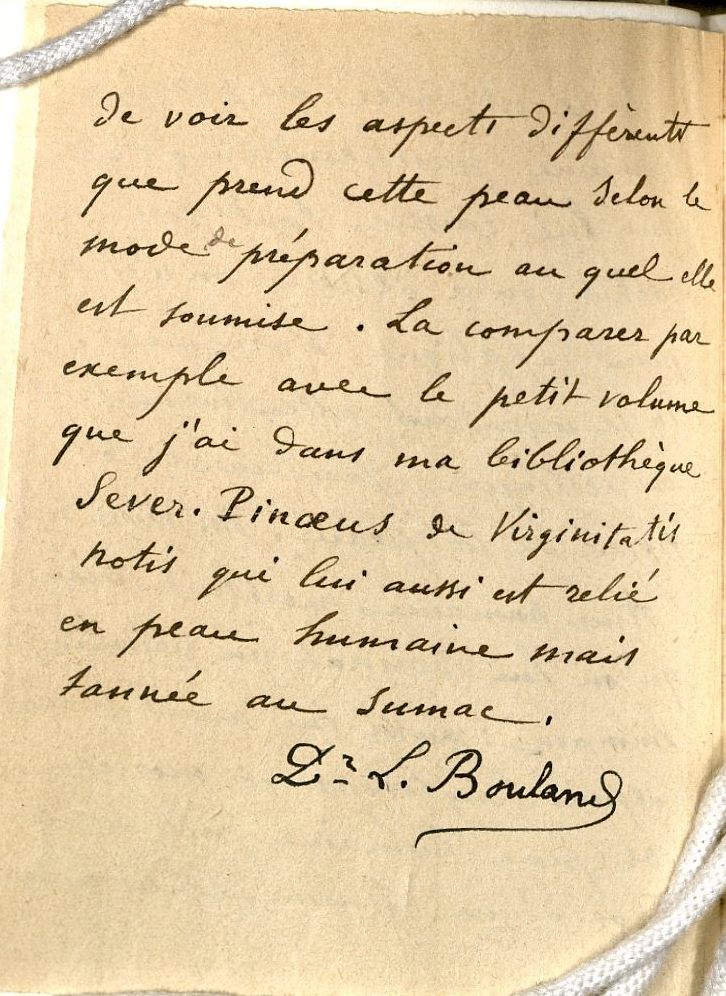The True Practice of Binding Books in Human Skin
 Paul Cézanne, “Still life with skull, candle, and book” (via Wikimedia)
Paul Cézanne, “Still life with skull, candle, and book” (via Wikimedia)
There are a few urban legends that poke up here and there that certain libraries — usually dusty, private, or academic ones which are not easily accessible by the public — hold books bound in human skin. Few of these stories turn out to be true: the “human” skin is often proven to be lamb, sheep, or deer. But Harvard University’s Houghton Library was recently surprised — and somewhat taken aback — to find one of its books was absolutely an example of the practice known as anthropodermic bibliopegy.
 The book in question (pictured here courtesy Houghton Library, Harvard University), a French volume titled Des destinées de l’ame by Arsène Houssaye, is also relatively recent, dating only to the 1880s. Making the object even stranger, the book examines the nature of the soul and life after death. Though the use of human skin to bind a book is rare, examples date to the 16th century and the “donors” were often convicted criminals.
The book in question (pictured here courtesy Houghton Library, Harvard University), a French volume titled Des destinées de l’ame by Arsène Houssaye, is also relatively recent, dating only to the 1880s. Making the object even stranger, the book examines the nature of the soul and life after death. Though the use of human skin to bind a book is rare, examples date to the 16th century and the “donors” were often convicted criminals.
Houghton’s book, however, is bound in the skin of an unwilling participant, an unnamed woman who died of apoplexy or a stroke while confined to a mental institution. The author, Houssaye (1815-1896), presented this copy of the publication to his friend, a medical doctor and book collector named Ludovic Bouland (1839-1932).
It was Bouland who chose to use the skin of a deceased patient, whose body had remained unclaimed by friends or relatives. By the 1930s, another bibliophile acquired the book and deposited it with Houghton Library. Accompanying the book was a note from Dr. Bouland describing the origin of the book’s gruesome binding.
 Note from Bouland explaining the book’s origin (courtesy Houghton Library, Harvard University)
Note from Bouland explaining the book’s origin (courtesy Houghton Library, Harvard University)
More recently, Harvard staff tested the book to determine the veracity of Bouland’s claim. Using techniques including “Liquid Chromatography-Tandem Mass Spectrometry” (LCMSMS) and assessing the “peptide mass fingerprint” (PMF), tests announced this June proved with 99% certainty that the binding of this book was human skin. It is the only proven example of anthropodermic bibliopegy at Harvard.
Two other Harvard libraries — the Harvard Law Library and Countway Library of the Harvard Medical School — also claimed to have similarly bound books, but tests proved the skin came more conventional sheepskin. The book from the Law Library, a Spanish law book, included the horrific description that its source was Joans Wright who, according to an inscription in this copy, “was flayed alive” in 1632.
A 1933 article from the Harvard Crimson refers to an example slightly less gruesome: a miniature book titled Little Poems for Little Folk was bound in the skin of a donor who remained happily alive and healthy after the removal of 20 square inches of skin from his back. The book was privately owned; the book’s current whereabouts are unknown.
Not so far from Harvard, the Boston Athenaeum also owns a skin bound in human skin: a memoir of James Allen, which Allen wrote himself and specifically requested be bound in his skin. The book is often on display in the library and remains one of the most well-known examples of anthropodermic bibliopegy thanks in part due to frequent mentions on walking tours highlighting spooky local history.
Houghton staff note that the object is not merely a macabre piece nor an object of morbid curiosity, but also as a reminder that practices, no matter how unsettling to those in the 21st century, were at one time, in at least one place, considered acceptable.










Follow us on Twitter to get the latest on the world's hidden wonders.
Like us on Facebook to get the latest on the world's hidden wonders.
Follow us on Twitter Like us on Facebook